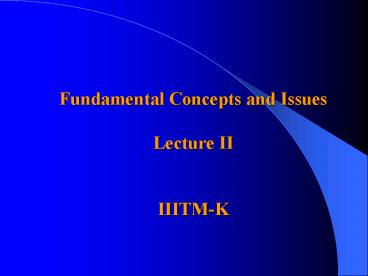Fundamental Concepts and Issues Lecture II IIITMK - PowerPoint PPT Presentation
1 / 20
Title:
Fundamental Concepts and Issues Lecture II IIITMK
Description:
remote access of email and files using technology known as Virtual Private ... A bit belongs to a binary number system whose values consist of 0s and 1s. ... – PowerPoint PPT presentation
Number of Views:39
Avg rating:3.0/5.0
Title: Fundamental Concepts and Issues Lecture II IIITMK
1
Fundamental Concepts and IssuesLecture
IIIIITM-K
2
FUNDAMENTAL CONCEPTS
- What is a network?
- In its simplest form, networking is defined as
two computers being linked together, either
physically through a cable or through a wireless
device. - Recently developed benefit of networks
- -remote access of email and
files using technology known as Virtual Private
Networking (VPN) - - an organization can access
its network remotely via a secure, encrypted
channel by means of either a dialup or Internet
connection.
3
Digital etiquette bursts, bits, and packets
- A computer network requires two hosts and a wire.
Now we must examine how the hosts use this wire
to communicate. - The term "digital" means that a device uses
bursts of electricity in discrete values. - one discrete burst represent a bit set to one. A
low voltage burst of zero represents a bit set to
zero. - A bit belongs to a binary number system whose
values consist of 0s and 1s.
4
- A packet is a discrete number of bursts onto the
wire whose contents are understood by the hosts
connected on the network. - Exchanging of packets between computers on a
network is referred to as a packet-switched
network. - The breaking up of data into pieces, packets, is
the fundamental concept of network operation.
5
(No Transcript)
6
(No Transcript)
7
(No Transcript)
8
PROTOCOLS
- Specifies common set of rules and signals which
computers on the network use to communicate. - Proprietary protocols Are standards developed
and protected by hardware manufacturers. - Open protocols Are nonproprietary protocols.
They are established by independent
organizations. - Protocol suiteThe total package of protocols.
9
NETWORK TOPOLOGY
- specifies the geometric arrangement of the
network or a description of the layout of a
specific region. - The complete physical structure of the cable (or
data-transmission media) is called the physical
topology . - The way data flows through the network (or
data-transmission media) is called the logical
topology.
10
TYPES OF CONNECTIONS
- POINT-TO-POINT
- provides a direct link between two
devices for example, a computer connected
directly to a printer . - MULTI-POINT
- provides a link between three or more
devices on a network.
11
NETWORK ARCHITECTURE
- Peer-to-Peer
- Client/Server
- a peer-to-peer network does not have a central
server and consists of 2 or more computers
connecting through a device called a Hub. - Client/server networks are networks that connect
individual computers, known as clients, and one
or more central computers, called servers.
12
Local Area Networks (LANs)
- LANs connect computers and peripherals within a
building or group of buildings. - Users can access software, data, and peripherals.
- LANs require special hardware and software.
- Computers connected to a LAN are called
workstations or nodes. - Different types of LANs
- Peer-to-peer
- Client-server
13
Switching Strategies
- circuit switching dedicated circuit
send/receive a bit stream - packet switching store-and-forward send/receive
messages (packets)
14
Addressing and Routing
- Address byte-string that identifies a node
usually unique - Routing process of determining how to forward
messages towards the destination node based on
its address - types of addresses
- unicast node-specific
- broadcast all nodes on the network
- multicast some subset of nodes on the network
15
Common Multiplexing Strategies
- Time-Division Multiplexing (TDM)
- Used for telephony or other applications where
there is a constant bit rate - Frequency-Division Multiplexing (FDM)
- Frequencies on the physical media are used for
different channels
16
Application Modes
- Network supports common process-to-process
channels - sockets, ping, etc
- Request/Reply for file access and digital
libraries - ftp, telnet
- Message Stream for video applications
17
What Goes Wrong in the Network?
- Bit-level errors (electrical interference)
- bit errors 10-7 for copper, 10-12 for fiber
- With Gbps line, 10/second with copper
- Packet-level errors (congestion)
- Adjust to match bit error rate
- Link and node failures
- Redundant equipment switches over on the order of
days
18
Failure Modes
- Messages are delayed
- Messages are corrupted
- Messages are delivered out-of-order
- Third parties eavesdrop
- The key problem is to fill in the gap between
- what applications expect and what the
- underlying technology provides.
19
Performance measures
- 1.Bandwidth (throughput)
- Amount of data that can be transmitted per time
unit. Example 10Mbps - link versus end-to-end
- Notation
- --KB 210 bytes
- --Mbps 106 bits per second
- Bandwidth related to bit width
20
Latency (delay)
- Time it takes to send message from point A to
point B - Example 24 milliseconds (ms)
- Sometimes interested in in round-trip time (RTT)
- Components of latency
- Latency Propagation Transmit Queue
- Propagation Distance / Speed Of Light
- Transmit Size / Bandwidth































